#icy exoplanet
Text
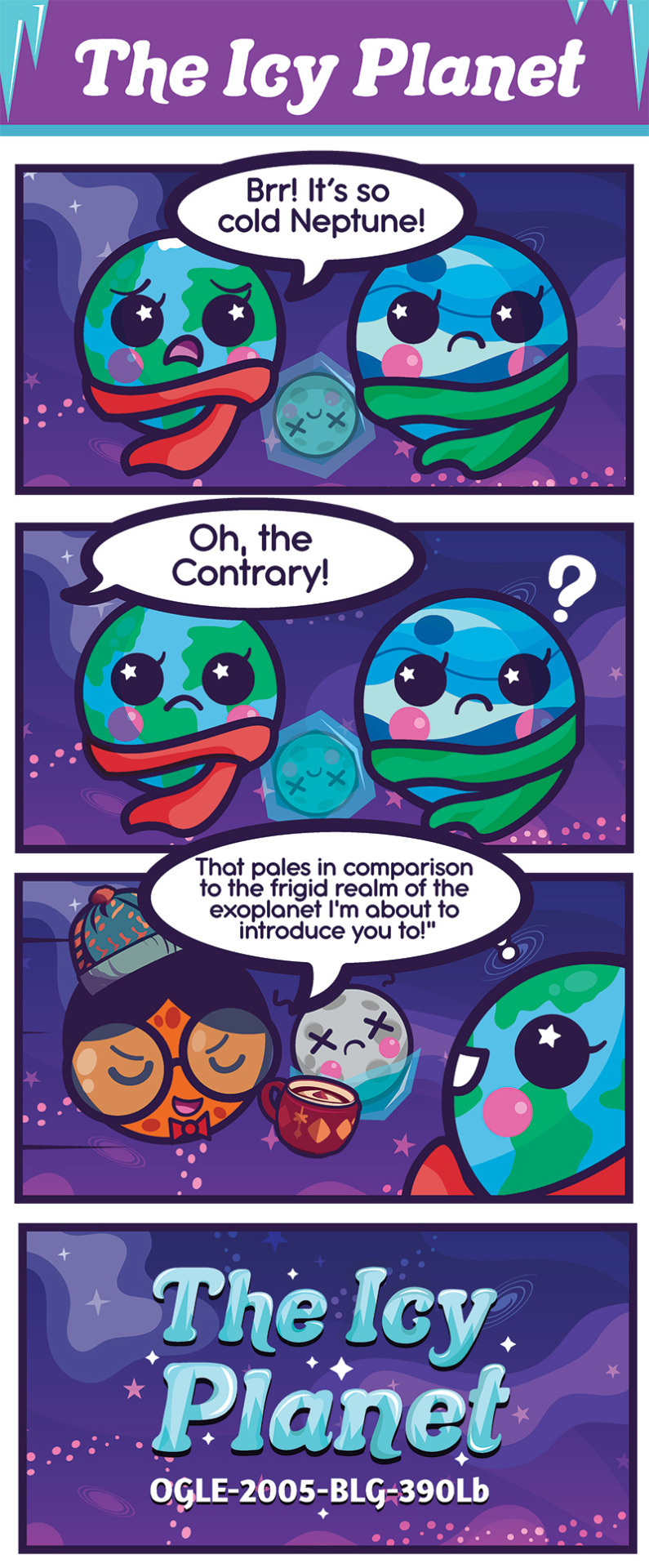



Back and better than the ever! Here’s a comic in the cold exoplanet, OGLE-2005-BLG-390Lb!
https://hubblesite.org/contents/news-releases/2006/news-2006-06.html
https://exoplanets.nasa.gov/exoplanet-catalog/6081/ogle-2005-blg-390l-b/
#cosmic funnies#astronomy#space#cute#science#kawaii#reblog#blog update#stars#educational#cold#icy#icy exoplanet#exoplanet#exoplanets#winter#outer space#web comics#webcomic
209 notes
·
View notes
Text
NASA: Some Icy Exoplanets May Have Habitable Oceans and Geysers
A NASA study expands the search for life beyond our solar system by indicating that 17 exoplanets (worlds outside our solar system) could have oceans of liquid water, an essential ingredient for life, beneath icy shells. Water from these oceans could occasionally erupt through the ice crust as geysers. The science team calculated the amount […]
from NASA https://ift.tt/7diBY4q
0 notes
Note
please please please PLEASE share more on your Thoughts about gas giants!! i'd love to learn in a way that doesnt leave me baffled and half my brain leaking from my ears! you explained things so well in the psyche post and also i think things are generally more fun to learn from someone who is Excited To Share than from Published Research Papers where everything has been dried out For Professional Reasons- understandably so, mind, but i am not In The Field and dont know the terms lol
Okay it's taken me forever to get back to this but I AM SO GLAD YOU ASKED.
Like other planets, it all starts with a disk made of gas and dust orbiting an infant star, called a protoplanetary disk. Like these in the Orion Nebula, discovered by the Hubble!

To form terrestrial planets (rocky planets with relatively thin atmospheres like Mercury, Venus, Earth, and Mars), the gas in the protoplanetary disk coalesces to form hundreds and hundreds of rocky bodies called planetesimals, about a kilometer across. These planetesimals collide, and form dozens of protoplanets about the size of the moon. The protoplanets then collide as well, and stabilize to form the solar system as we know it today.
But, in the case of gas giants, colliding protoplanets don't form fully-finished planets. Instead, they form a core, or a seed.
We think the only thing that determines whether a planet will be terrestrial or a gas giant is simply how far away from the sun it forms - that's it. As a new sun warms its evolving solar system, it heats up the material in the protoplanetary disk. Close to the sun, the disk gets hotter, and things like water and other ices melt and evaporate into gas, making them difficult for the protoplanets to gravitationally capture. However, further away, the icy compounds stay cold enough to remain solid and coalesce along with rocky particles.
That boundary in the solar system - where ices evaporate to gas on the sunward side, and remain solid on the other - is called the "Frost Line". In our solar system, the Frost Line is right between Mars and Jupiter.

The protoplanets that form past the Frost Line turn into gas giant seeds, and are able to (kinda literally) snowball, picking up both rocky and icy material. With all that solid ice available, they grow far larger and far faster than planets in the inner solar system, and their gravity gets stronger and stronger. More gravity causes them to collect even MORE material until they're heavy enough to capture extremely lightweight elements like hydrogen and helium. Which, of course, makes them get even bigger and even heavier! Runaway growth!
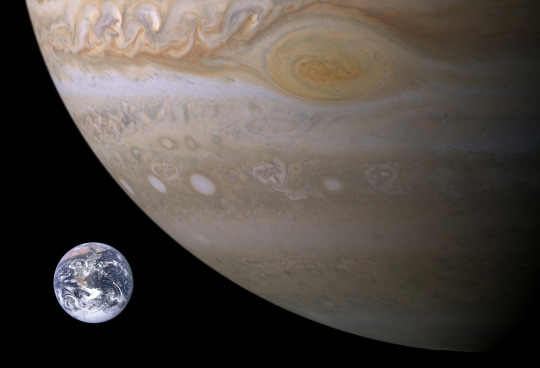
But weirdly, as we study more exoplanets (planets that orbit stars other than our sun), we keep finding these huge gas giants incredibly close to their stars! Like, even closer than Mercury is to ours, which is insane. These "Hot Jupiters" break so many rules - gas giants "should" only be able to form where ice stays frozen, but here they are up close and personal with their stars, like this artist's concept!

It's possible that these planets are in the process of migrating closer to their stars, and we're managing to see them before they evaporate, but we just! Keep! Finding them!
One of my favorite parts of planetary science is how much we still have to learn. We'll think we have a pretty good idea of how things work out there, and then suddenly we'll find something that we can't explain. And there's an entire universe of weird shit - we've barely begun to scratch the surface!
#space#planets#jupiter#gas giants#astrophysics#planetary formation#Hubble#spost#asked and answered#anxiousdemifaemess#it's crazy though#in the early solar system about 98% of the material in the protoplanetary disk is hydrogen and helium#which is so lightweight it's entirely unavailable for planetary formation#it never coalesces and eventually just blows away#or gets eaten by the star#gas giants are able to utilize even a tiny fraction of that material#which is why they get so big!#The Frost Line is the reaso all our gas giants are far away and why we don't see rocky planets like mars hanging out past Jupiter and Satur#Or rather it would be#IF HOT JUPITERS WEREN'T EVERYWHERE RUINING THAT THEORY
143 notes
·
View notes
Text
As far as we know, life needs water.
Due to this simple truth, astronomers and astrobiologists have naturally focused their efforts on identifying exoplanets that might harbor liquid oceans. Water in its liquid form can exist on a planet's surface, where direct heat from its host star can keep the substance from freezing — but it can also exist beneath a planet's surface, where internal sources of heat can sustain flowing, subsurface oceans.
In a new analysis, NASA has revealed that 17 discovered exoplanets could house subsurface oceans buried below thick sheets of ice. These worlds, much like the icy moons of Jupiter, could therefore be promising places to search for biosignatures — chemical signs of life.
Continue Reading.
67 notes
·
View notes
Text
Some thoughts on Alpha Centauri

Alpha Centauri is a binary star system ~4.3 light years away from Earth. Appearing as a single bright point of light, it was first recorded by Ptolemy in his astronomical treatise The Almagest(1) in 150AD, but it wasn't discovered to be a pair of two stars orbiting each other until the late 1600's.(2)
(1) I'd bet dollars to donuts Aziraphale has a copy.
(2) Alpha Centauri was only like the second binary star system to be discovered. Given Crowley and Aziraphale made the Arrangement only a few scant decades earlier, I can't help but imagine Crowley would romanticize the idea of two bright glowing beacons bound by gravitational force to perpetually circle each other.
Between Earth and the Alpha Centauri system is the Oort Cloud, a band of millions of comets and other icy planetary debris loosely orbiting the sun.

For the sake of creative license (and ~~romance~~), I imagine the Oort Cloud would be like being surrounded on all sides by a perpetual meteor shower. Wouldn't that be a sight to see, with the ethereal being you care for most in the universe at your side?
Past the Oort Cloud, the next stop on the way to Alpha Centauri is Proxima Centauri, the closest star to Earth. It's a cool, small red dwarf that orbits its bigger binary neighbors Alpha Centauri A and B. It's also a flare star, so every so often it gives off bright flashes of solar wind. It has an exoplanet closer to its surface than Mercury is to our sun, offering an angel and demon on a romantic holiday a front-row seat to its spectacular lights show.

Stargazing from another solar system would take on completely new meaning. In the night sky from Alpha Centauri, the constellation Cassiopeia would be visible, as would the Earth's sun.

But seeing the galaxy from such a new and drastically different vantage point would provide the opportunity to come up with new myths and constellations. What could be a more perfect activity for two ethereal-slash-occult-beings to wile away a decade or a few chatting over a picnic basket chock full of favorite treats from Earth?(3)
(3) Said favorite treats from Earth would mostly comprise of fine red wine, biscuits, and petit fours, of course.
But back on earth, if Aziraphale never agrees to go with Crowley to Alpha Centauri, well...Crowley rather doesn't see the point of taking the trip alone. Feeling rejected and heartbroken, if he wanted to go for a sulk, he could miracle himself to the opposite side of the planet from England to the South Pacific, where Alpha Centauri is visible in the night sky year-round. He could spend as long as he wanted staring up at those faraway stars bound together in eternal orbit in the constellation Centaurus and think about what could have been.

#good omens#aziracrow#aziraphale x crowley#crowley x aziraphale#ineffable husbands#good omens s2 spoilers#good omens headcanons#crowley loves aziraphale#ineffable divorce#good omens spoilers#alpha centauri
48 notes
·
View notes
Text



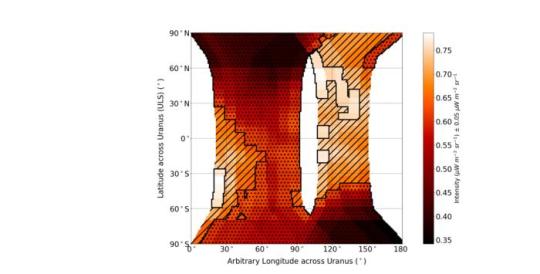
Uranus aurora discovery offers clues to habitable icy worlds
The presence of an infrared aurora on the cold, outer planet of Uranus has been confirmed for the first time by University of Leicester astronomers.
The discovery could shed light on the mysteries behind the magnetic fields of the planets of our solar system, and even on whether distant worlds might support life.
The team of scientists, supported by the Science and Technology Facilities Council (STFC), have obtained the first measurements of the infrared (IR) aurora at Uranus since investigations began in 1992. While the ultraviolet (UV) aurorae of Uranus has been observed since 1986, no confirmation of the IR aurora had been observed until now. The scientists’ conclusions have been published in the journal Nature Astronomy.
The ice giants Uranus and Neptune are unusual planets in our solar system as their magnetic fields are misaligned with the axes in which they spin. While scientists have yet to find an explanation for this, clues may lie in Uranus’s aurora.
Aurorae are caused by highly energetic charged particles, which are funnelled down and collide with a planet's atmosphere via the planet's magnetic field lines. On Earth, the most famous result of this process are the spectacles of the Northern and Southern Lights. At planets such as Uranus, where the atmosphere is predominately a mix of hydrogen and helium, this aurora will emit light outside of the visible spectrum and in wavelengths such as the infrared (IR).
The team used infrared auroral measurements taken by analysing specific wavelengths of light emitted from the planet, using the Keck II telescope. From this, they can analyse the light (known as emission lines) from these planets, similar to a barcode. In the infrared spectrum, the lines emitted by a charged particle known as H3+ will vary in brightness depending on how hot or cold the particle is and how dense this layer of the atmosphere is. Hence, the lines act like a thermometer into the planet.
Their observations revealed distinct increases in H3+ density in Uranus’s atmosphere with little change in temperature, consistent with ionisation caused by the presence of an infrared aurora. Not only does this help us better understand the magnetic fields of the outer planets of our own solar system, but it may also help in identifying other planets that are suitable of supporting life.
Lead author Emma Thomas, a PhD student in the University of Leicester School of Physics and Astronomy, said: “The temperature of all the gas giant planets, including Uranus, are hundreds of degrees Kelvin/Celsius above what models predict if only warmed by the sun, leaving us with the big question of how these planets are so much hotter than expected? One theory suggests the energetic aurora is the cause of this, which generates and pushes heat from the aurora down towards the magnetic equator.
“A majority of exoplanets discovered so far fall in the sub-Neptune category, and hence are physically similar to Neptune and Uranus in size. This may also mean similar magnetic and atmospheric characteristics too. By analysing Uranus's aurora which directly connects to both the planet's magnetic field and atmosphere, we can make predictions about the atmospheres and magnetic fields of these worlds and hence their suitability for life.
"This paper is the culmination of 30 years of auroral study at Uranus, which has finally revealed the infrared aurora and begun a new age of aurora investigations at the planet. Our results will go on to broaden our knowledge of ice giant auroras and strengthen our understanding of planetary magnetic fields in our solar system, at exoplanets and even our own planet."
The results may also give scientists an insight into a rare phenomenon on Earth, in which the north and south pole switch hemisphere locations known as geomagnetic reversal.
Emma adds: “We don't have many studies on this phenomena and hence do not know what effects this will have on systems that rely on Earth's magnetic field such as satellites, communications and navigation. However, this process occurs every day at Uranus due to the unique misalignment of the rotational and magnetic axes. Continued study of Uranus's aurora will provide data on what we can expect when Earth exhibits a future pole reversal and what that will mean for its magnetic field.”
TOP IMAGE....An artistic representation of how the northern infrared aurora would have looked like in 2006 (marked in red). The darker red locations indicate confirmed aurora locations, with fainter red used to mark possible aurora locations. Credit to NASA, ESA and M. Showalter (SETI Institute) for the background image of Uranus, as was observed by the Hubble Space Telescope (in the visible spectrum) in August 2005. CREDIT Credit to NASA, ESA and M. Showalter (SETI Institute) for the background image of Uranus, as was observed by the Hubble Space Telescope (in the visible spectrum) in August 2005.
CENTRE IMAGE....Averaged emission spectrum between 3.4 and 4.0μm, with annotated positions of valuable H3+ emission lines (known as Q lines) found at specific wavelength locations, the brightness of each line is determined by both temperature and density of the H3+ particles in a planet's atmosphere CREDIT Source: University of Leicester
LOWER IMAGE....Measured infrared brightness from the upper atmosphere of Uranus combined with rings of magnetic field lines which occur as the planet rotations (which produces the oval shape we see in most aurora). These rings are called shells and we expect the majority of auroral signal to occur between the dashed and dotted lines (as seen in 1986), which a portion of our results do. CREDIT Source: University of Leicester
BOTTOM IMAGE....Measured infrared brightness from the upper atmosphere of Uranus over a 6-hour period, areas highlighted with a black border and no hash or dots are locations of enhanced emission (aurora). Hashed areas means possible aurora though the signal is too weak to confirm and dotted areas means no aurora in these points. CREDIT Source: University of Leicester
42 notes
·
View notes
Photo

NASA’s Cassini spacecraft captured this image of Enceladus on Nov. 30, 2010. The shadow of the body of Enceladus on the lower portions of the jets is clearly visible. NASA/JPL-Caltech/Space Science Institute
NASA: Some Icy Exoplanets May Have Habitable Oceans and Geysers - NASA
23 notes
·
View notes
Photo
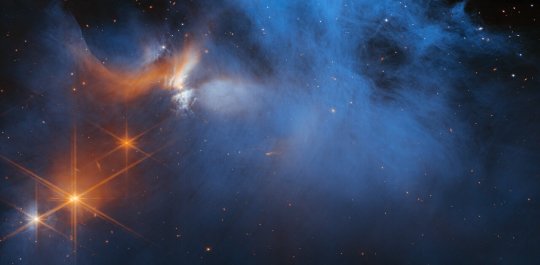
(via Webb Unveils Dark Side of Pre-stellar Ice Chemistry | ESA/Webb)
The discovery of diverse ices in the darkest, coldest regions of a molecular cloud measured to date has been announced by an international team of astronomers using the NASA/ESA/CSA James Webb Space Telescope.
This result allows astronomers to examine the simple icy molecules that will be incorporated into future exoplanets, while opening a new window on the origin of more complex molecules that are the first step in the creation of the building blocks of life.
If you want to build a habitable planet, ices are a vital ingredient as they are the main carriers of several key light elements — namely carbon, hydrogen, oxygen, nitrogen, and sulphur (referred to collectively as CHONS). These elements are important ingredients in both planetary atmospheres and molecules like sugars, alcohols, and simple amino acids. In our Solar System, it is thought they were delivered to Earth’s surface by impacts with icy comets or asteroids.
64 notes
·
View notes
Note
Top 5 planets!!!
😍 Thanks for the fun ask, aquaticpal! I'm going to modify this slightly because I already put Earth as my favorite celestial body of all in my previous post about that. I'll do my top 5 planets excluding Earth so I don't repeat myself.
Counting down!
5. Pluto
If you've been paying attention to some astronomy in the last decade or two, you probably know Pluto isn't being called a "Planet" officially anymore.
...I don't care.

The image above shows Pluto (lower right) and its large moon Charon (upper left) as imaged by the New Horizons probe. The frozen heart-shaped feature on Pluto's icy surface melted my own heart (and I wasn't alone).
The whole hullabaloo about Pluto not being a planet is just semantics. It's a celestial body with enough gravity to be round, and it orbits the Sun. I'll count it.
So, why does it make it to my favorites list?
Pluto is geologically active (like Earth - it has its own geology happening on its surface, like volcanoes, tectonics, and erosion), a reality many did not expect until the New Horizons spacecraft started returning close-up pictures of this distant world. The smoothness of Pluto's signature heart-shaped feature (particularly the left side) is a dead giveaway that geological activity is happening on its surface. Worlds where there's no active geology are covered in craters everywhere, not just in some places, and the more recently it's been active the fewer craters there are per area. So.... Pluto is a 'living world' with enough energy inside it to make its insides move.
Cool.
It might be the close orbit of its moon Charon causing it - the shifting gravity stirring up Pluto's innards (and Charon's!), causing friction, and thus heat.
Either way, there's enough geological activity on Pluto to create these gorgeous mountains:
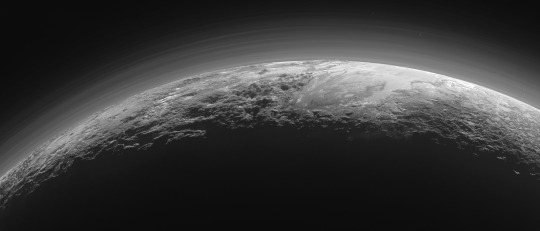
It has seasons during which the frozen nitrogen at its surface becomes warm enough to create mists - nitrogen fog. Imagine if Earth were cold enough that our very air would turn into blocks of ice that create white vapor - kind of like dry ice does.
Pluto is fascinating: a world that defied our expectations. I love it.
4. Trappist-1f

This artist's rendition shows what exoplanet Trappist-1f might look like if it has liquid surface water. It's too small and too far away to get an actual picture, but the evidence shows this planet exists in the habitable zone of its star.
The Trappist-1 star system lies about 40 light-years from Earth (very nearby in the grand scheme of things). Within it, seven planets orbit a small, cool red dwarf star (that's Trappist-1). The planets don't have 'given' names like Pluto or Earth. They're assigned letters b-h, with b the closest and h the furthest from the star. Planets e, f, and g are all in the star's habitable zone, which means they could have liquid water on their surfaces.
So, why did I specifically pick Trappist-1f? It's the planet most perfectly centered in the habitable zone, and its properties are all quite similar to Earth's: it's radius, mass, density, and surface gravity. In order to be hospitable to life as we know it, it's important for a planet to be able to keep itself warm (not just from the light from its Sun - it needs its own, internal heat source, too, to stay geologically active and produce a protective magnetic field - this keeps the atmosphere stable rather than letting its sun's radiative wind blow lots of it away, and also protects life on its surface from that same radiation that would split our complex organic components apart).
Trappist-1f is extremely close to its star, but the star is very cool, so it's unlikely to be very hot. It only takes the planet 9.2 days to orbit the star once. (Yes, you read that right - Trappist-1f's year is only 9.2 Earth days long! If you lived there, I bet you'd find some other way to celebrate birthdays. You'd be having a party just about every week).
I'm all for finding planets that might have water, and therefore might have life... or might be good for us to live on, some day.
The other cool thing about its place is ALL the planets are quite close to the star, so they'd appear huge in the sky regardless of which of the other planets you were standing on. This is a cool, artistic interpretation of that:

3. Proxima Centauri b
Speaking of places where we might be able to live...
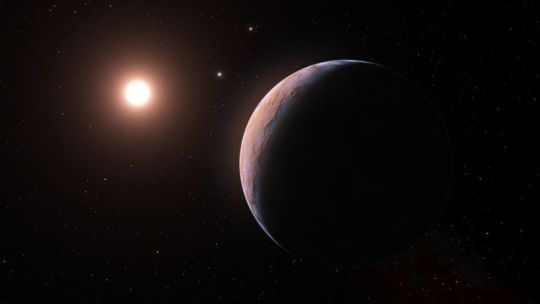
...welcome to Proxima Centauri b - the nearest exoplanet to Earth... and also in its star's habitable zone.
Proxima Centauri b is a small, cool, red dwarf star part of the Alpha Centauri system, a triple-star system consisting of two brighter stars (Alpha Centauri A and Alpha Centauri B, both similar to the Sun) which are close to each other, and the cool red dwarf Proxima Centauri b, still orbiting the others but much farther away.
And around that small cool dwarf star is a planet not too different from Earth.
I can't stress enough how incredible that is.
This is the very nearest star system to our own, only four light-years from here.
And in it, there is already a possible stepping stone for us to move outward into the Cosmos. And not just a stepping stone, but possibly somewhere habitable.
Wow.
We need to learn more about this planet. It may or may not be hospitable. It may or may not have an atmosphere. We just don't know yet. But it's hope. It's one of many signs that the galaxy is absolutely littered with planets, and there may be many worlds like ours.
2. Jupiter
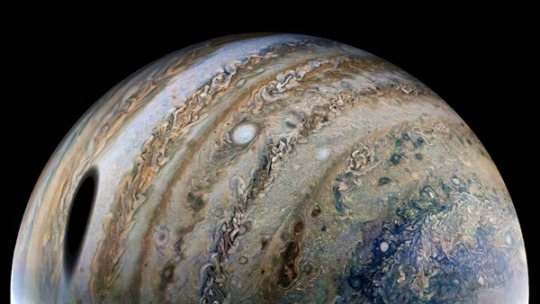
This image taken by the Juno Probe shows a lot of what makes Jupiter awe-inspiring: roiling masses of hydrogen and helium gas with traces of methane, ammonia, silica, and sulfur creating myriad colors in its clouds, storms which could swallow several Earths whole, and of course its huge mass which make it a gravitational well, holding on to a minimum of 80 moons. The huge shadow of its moon Ganymede is visible on the left-hand side in the picture.
First of all, Jupiter is, quite simply, beautiful. Just look at it.
All those colors, the swirls, its absurdly fast rotation (a 10-hour period!) pulling its clouds out into these thin bands. It's so striking. Add to that the shadows of its many moons crossing its surface, and you have a recipe for endless visual fascination.
But that alone isn't enough to make it one of my favorites.
I love Jupiter because it protects us.
Jupiter's gravity is so strong it tends to divert and even capture many objects which hurtle inward toward the Earth and the other inner planets, meaning fewer things actually hit the Earth than they otherwise would. Jupiter is the batter at plate, and we're the catcher. We really don't want any of those strikes thrown to cross the plate.
Thank-you, Jupiter.
I also love Jupiter because it provides a home for other worlds - the moons Europa and Ganymede in particular - which might be places to find life. Europa's the far more likely of the two, but I won't belabor that point. Suffice to say, Jupiter's gravity provides the energy that keeps Europa active, with an underground ocean, potentially a safe haven for organic life. I hope to live long enough to find out.
Mars
My pattern by this point is probably clear. I'm rooting for life and for places we could move to one day. The absolute tippy-top of that list is Mars.
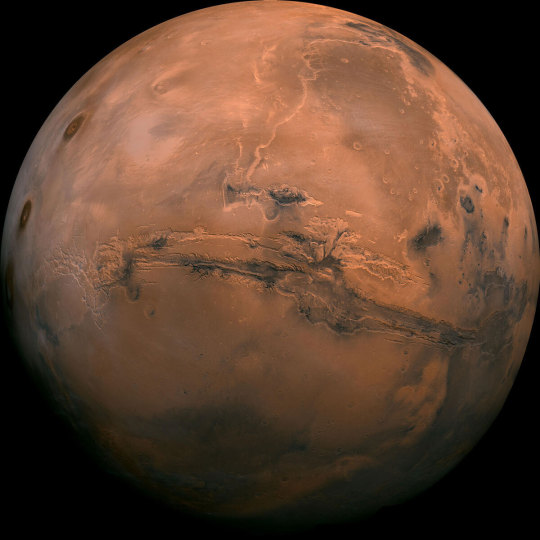
This image shows many features of Mars which show past geological activity and the outline of what once was the shore of a truly vast ocean.
The more missions we send to Mars, the more likely we realize it is that Mars could once have had life on its surface, and could even harbor it right now below ground.
You can see the outlines of several ancient volcanoes in the left-hand side of this picture, and a truly massive TEAR in the planet's surface front-and-center. That thing is as long as the entire continent of North America. There are plenty of craters, which means it hasn't been geologically active ( at least not much) in a long time, but the signs of past activity on its surface are clear. It has dry riverbeds. Dry ocean beds. Dry lake beds. Dry glacial footprints. Ancient volcanoes. The robots we've landed to explore the surface have found clear, smoking-gun type evidence of past running water in these places (clay is a big one, and there's hematite, too), and the basic components for life are there. The one thing we haven't found yet is life itself.
We now understand Mars lost its once-watery exterior thanks to it being too small. Its interior cooled off, slowing and nearly stopping geological activity entirely, and stopping Mars' rotation from creating a magnetic dynamo like Earth has - so Mars lost its protective magnetic bubble stopping the Sun's radiation from striking its atmosphere and surface. The Sun basically blew Mars' air away into space, and irradiated its top soil. So.. the top two inches of the soil are entirely barren.
But RIGHT below that.... we have found water ice. And below that... there are underground rivers. Sinkholes and orbital measurements of density have shown that.
We might be able to send people there and have them survive underground. We'd need some way to deal with Mars' lost protective bubble at some point if we wanted to make the surface habitable. Dome cities might be okay, though those always creep me out. I just picture something puncturing it and causing problems. But.... it's so close. And it might have life, or once had it.
I have so much to say about all these places, but if I keep going this will just become interminable. So... I'll stop. Here's my list. I hope you enjoy!
#answering asks#top 5 planets#mars#jupiter#pluto#trappist-1f#proxima centauri b#astronomy#a bit of planetary geology#planets#what makes planets spiffy#the search for life#and livable places#thanks for the ask#long post
32 notes
·
View notes
Text
Fun Ocean Planet Facts I love learning for my book
A water planet needs a strong magnetic field to protect its atmosphere, otherwise greenhouse gases will cause the planet to heat up over time, the ocean to boil, and vapour to escape into space via solar wind (like Venus and Mars)
Gas giants like Jupiter and Saturn, thought to lack surfaces and have a stratum of liquid nitrogen.
Although still not fully understood, ice giants like Uranus and Neptune have hot, highly compressed, supercritical water. However, the "ocean" on Neptune, might actually be liquid diamond.
There are currently five known water planets in habitable zones. Kepler-22b "Super Earth" is 2.4 times the size of Earth. It is currently unknown if it has a rocky, gaseous or liquid composition, but it does have clouds.
Kepler-453b is 60% bigger than Earth, orbiting a star 10% larger than our sun and 20% brighter. The temperature is warm enough to have an ocean and house life.
Kepler-62 has five planets orbiting a star 2/3 the size of our sun and only 1/5 as bright. At 7 billion years old it is older than our solar system and two of the planets are habitable zones and 40% larger than Earth.
HAT-P-11b is a planet the size of Neptune, making it the smallest exoplanet to have water, it sits so close to its sun in a five-day orbit, it's too warm to have an ocean, but it still has water vapour and cloudless skies.
Ganymede (Jupiter's largest moon) proves that satellites can have their own magnetic field and underground saltwater oceans.
Callisto, Jupiter's second largest moon, is equal parts rock and ice with the lowest density of any moon. Its structure is composed of an icy-rock crater exterior, a thin saltwater secondary layer, and finally an ice-rock core.
Enceladus, Saturn's sixth largest moon, is covered in a thin smooth sheet of ice, making it the most reflective body in our solar system. It also has an underground ocean, with venting plumes of water vapour escaping into space from giant fissures in its southern pole that are so big the moon looks like it has tiger stripes.
Titan, Saturn's largest moon, has the saltiest subsurface ocean of any moon. It's currently unknown if Titan's ocean is a very thin layer sandwiched between sheets of ice, or if it extends all the way down to its rocky interior. There are lakes and rivers visible on Titan's surface, but it's not saltwater, its liquid hydrocarbons (methane and ethane)
Triton, one of Neptune's moons, has active geysers that spew nitrogen into the atmosphere, and volcanic fixtures cover the icy rock surface, most likely the result of past tidal heating.
Dwarf Planet Pluto has mountains of water ice and flowing glaciers of nitrogen and methane ice. Mysterious fault lines, some hundreds of miles long, suggest that Pluto has a hidden subsurface ocean.
#research material#original story: aquarius#this is very important for worldbuilding reasons ok? I need to know how big the planet and sun are to each other#also I can give each moon its own unique look#I can have it as smooth as a pearl and god blinding#or volcanic and wrinkly as a golfball#and now I can at least confirm the colonies would be underground in the thin sandwiches ocean layer#and not on the surface as I originally imagined
5 notes
·
View notes
Text
The ocean off the coast of southern Florida is having a long, hot summer. For weeks, surface temperatures hovered around 90 degrees Fahrenheit, before dropping to the 80s last week. The world’s third-largest barrier reef is dying, and scientists are fishing out coral samples and bringing them to the cool safety of laboratory tanks. One spot along the coastline hit triple-digit temperatures last month, conditions you would expect inside a hot tub. Some coastal Floridians skipped their usual dips in the ocean because it didn’t seem appealing anymore.
Marine heat waves—periods of persistent and anomalously high temperatures of surface seawater—have materialized in other parts of the world too. The surface temperatures of about 44 percent of Earth’s oceans are currently experiencing extreme heat, according to the National Oceanic and Atmospheric Administration. Some of that warming is to be expected, because 2023 is an El Niño year. But “all of these marine heat waves are made warmer because of climate change,” Dillon Amaya, a research scientist at NOAA’s Physical Sciences Laboratory, told me. June was already a record-breaking month for the world’s oceans, and then July came along and topped it. According to the experimental forecast system that Amaya and his colleagues run at NOAA, half of the world’s oceans may be in the throes of a heat wave by September.
Earth is an ocean planet, a water world. We have not observed anything like it yet in the universe, not even with our best telescopes, and so we cannot know exactly how rare—and thus, how difficult—it may be for the forces of cosmic nature to produce such a thing. And yet, here we are, simmering its oceans at our peril and changing the fundamental makeup of the ecosystem that defines Earth. Our oceans have absorbed most of the excess heat produced by greenhouse-gas emissions in recent decades, serving as a buffer that protects us from the worst effects of climate change. Humans may be sweltering on land this summer, but our planet’s future—and therefore ours—is intimately tied with the sea.
Astronomers have spent years searching for worlds beyond our solar system that might host oceans, in the hopes that they also host life. Of the more than 5,000 planets they’ve found, only a few are in the habitable zone—at the right distance from their star to be conducive to liquid, flowing water. And scientists have yet to confirm that any rocky, Earth-size planets are also wet. Part of the problem is that oceans are difficult to detect with the technology available to researchers today. Our planet may be slick with rolling seas, but “if we were to observe Earth as an exoplanet, from a different system, we could not measure that Earth has water,” Charles Cadieux, an astronomer at the University of Montreal, told me.
Other oceans exist in our very own solar system but are hidden beneath the surface of icy moons, their exact composition unknown to us. Krista Soderlund, a research scientist at the University of Texas at Austin, studies Europa, a moon of Jupiter with a salty subsurface ocean that could harbor microbial life; she spends her days marveling at this other ocean world, all while worrying about the one she lives on. “I don’t really have a way to reconcile that,” Soderlund told me. “You can see the short, rapid changes right now, and then I’m looking forward to how that’s going to affect my kids. How much worse is it going to be?”
Next year, NASA is scheduled to launch the mission that Soderlund is working on: a spacecraft that will reach Europa in 2030. The vessel will carry a plaque engraved with a poem written by the U.S. poet laureate, which reads in part, “O second moon, we, too, are made / of water, of vast and beckoning seas.” This idea of connection, a touch of intimacy in an unfamiliar cosmos, is lovely. Read another way, it sounds almost like an elegy. We are made of vast seas. But when those seas are superheated, dissolving the shells and skeletons of marine creatures and enabling toxic blooms of algae, they beg for relief more than they beckon.
Our planet did not start out with seas. They came later, after Earth had cooled down from its formative molten years. How Earth got its water remains an open question; some researchers believe that it arrived inside asteroids that bombarded Earth several billion years ago, while others suggest that it was locked within the planet since it first formed out of the mountain-size rocks whizzing around the early solar system. This September, a NASA spacecraft will bring home samples from an asteroid that has remained unchanged since that cosmic period, and the rocky bits and pieces could reveal crucial information about our very existence. Scientists hope to uncover clues about the forces that gave rise to Earth’s oceans and enriched them with the chemical compounds that eventually sparked life.
In the face of climate change, the thrill of discovery is tinged with melancholy; as we learn more about how our ocean planet came to be, we’re subjecting its waters to intense heat, and the entire planet is facing the consequences. Hot oceans are melting ice sheets, intensifying hurricanes, and devastating fishing industries. “The Earth has seen a lot of change in its life,” Karen St. Germain, the director of NASA’s Earth-science division, told me. “But we are driving it now in a way that it hasn’t been driven before.”
Astronomers refer to the habitable region around a star as the Goldilocks zone. There, conditions are not too hot and not too cold, but just right for water to lap on alien shores. Earth is squarely in our sun’s habitable zone, and will enjoy its pleasant perch for at least another few billion years, until the sun grows hot enough to truly boil the planet’s oceans away. But Earth may become unlivable long before that: floods, droughts, wildfires, days so hot that touching asphalt can severely burn your skin, hot-tub seas that can roil coral and humans alike.
Last week, the head of the United Nations said, “The era of global warming has ended; the era of global boiling has arrived.” Climate scientists have cautioned that global boiling is not a scientific term, and that our current spate of extreme weather has been predicted for years. This is global warming, they say, and it’s plenty dramatic. Still, boiling can help emphasize the visceral urgency of what’s happening in the water. Because it is getting more difficult each day to look around and feel that things here are just right.
#current events#environmentalism#climate change#global warming#meteorology#astronomy#oceanology#ecology#water
5 notes
·
View notes
Note
Hello there! I hope that you are doing well! I am told that you are an astronomer! Is this correct? I have a friend who loves space very much. If you are indeed an astronomer, do you have any space facts or whatnot that I could give to them? Thank you!
Hello! Yes I am, and yes I'd be happy to! :D
Hmm, what's a fun planet fact.... Did you know that the architecture of our solar system (that is, the order that our planets are in and how far apart they are) is actually super weird compared to most of the exoplanet systems we've found out there? For a couple of reasons. One of them that I only learned recently is that we tend to think of Mercury as being super close to the sun, but most planetary systems we've found out there have planets much closer in that Mercury. Models show that you actually could have planets in our solar system closer to the sun than Mercury with stable orbits, and we just... don't. It's kind of weird, and it teases some interesting mysteries about how the solar system might have formed.
Here's a second fun space fact from one of my friends: There is a location on Charon (Pluto's moon) north pole called Mordor Macula (what a name!) It's interesting because it is a darker red color than the rest of Charon's surface, and the leady theory on why is that it is actually formed from condensed gases that escaped from Pluto's atmosphere! Something about their magnetic interaction could be funneling those gases as they escape into this location, and leaving behind all that icy residue. Cool!
If your friend has any questions most of my work is in exoplanets and stellar astronomy, so I'm best equipped answer things about planets, stars, and potential life out there in the universe. Stuff like cosmology, black holes, and dark matter is a little less in my wheel house, but I'll do my best to answer and I can always pass along questions to my colleagues who do study that stuff!
I usually try to keep this blog for my art and writing stuff, and do more general topics and chit chat on my other blog @papaya-inspiration, so it's easiest if you can submit asks over there. Looking forward to talking space stuff with you!
11 notes
·
View notes
Text
okay, let me finally tell you allabout the hvialkor species. (2.0)
origin: native to svorarya, an icy exoplanet.
classification: classified as a near-human species.
skin: from white to shades of grey, mirroring the gradient seen in human skin tones from lightest to darkest. ↳ additionally, hvialkor have an intricate pattern of skin markings that are imperceptible to the naked eye usually, distinct yet reminiscent of blaschko's lines. these skin markings make up a bioluminescent nervous system. this bioluminescent adaption serves a similar purpose as gaze direction or gaze cuing observed in other species.
eyes: black sclera and semi-transparent irises that appear white-grey. notably, their bioluminescence is observable through their unique iris, which exhibit shifts in both hue and vibrancy.
teeth: hvialkor have canine teeth reminiscent of those found in wolves and other canines, characterized by their canonical shape, sharpness, and how they recurve towards the skull.
addendum: blue blooded. (their blood is blue as their bodies use a protein called hemocyanin to bind oxygen, which involves an atom of copper rather than iron, as copper is more efficient at circulating oxygen through the body at very low temperatures.) their tongues and the inside of their cheeks are blue. natural split tongues, (to collect environmental information.) the men tend to be shorter than the women on average.
2 notes
·
View notes
Text
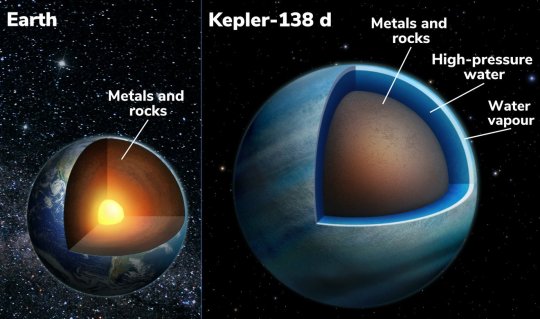
Two Exoplanets May Be Mostly Water, NASA’s Hubble and Spitzer
Though the telescopes can’t directly observe the planets’ surfaces, their densities indicate they’re lighter than rock worlds but heavier than gas-dominated ones.
A team led by of researchers at the University of Montreal has found evidence that two exoplanets orbiting a red dwarf star are “water worlds,” where water makes up a large fraction of the entire planet. These worlds, located in a planetary system 218 light-years away in the constellation Lyra, are unlike any planets found in our solar system.
The team, led by Caroline Piaulet of the Institute for Research on Exoplanets (iREx) at the University of Montreal, published a detailed study of this planetary system, known as Kepler-138, in the journal Nature Astronomy today.
Piaulet and colleagues observed exoplanets Kepler-138c and Kepler-138d with NASA’s Hubble and the retired Spitzer space telescopes and discovered that the planets could be composed largely of water. These two planets and a smaller planetary companion closer to the star, Kepler-138b, had been discovered previously by NASA’s Kepler Space Telescope. The new study found evidence for a fourth planet, too.
Water wasn’t directly detected at Kepler-138c and d, but by comparing the sizes and masses of the planets to models, astronomers conclude that a significant fraction of their volume – up to half of it – should be made of materials that are lighter than rock but heavier than hydrogen or helium (which constitute the bulk of gas giant planets like Jupiter). The most common of these candidate materials is water.
“We previously thought that planets that were a bit larger than Earth were big balls of metal and rock, like scaled-up versions of Earth, and that’s why we called them super-Earths,” explained Björn Benneke, study co-author and professor of astrophysics at the University of Montreal. “However, we have now shown that these two planets, Kepler-138c and d, are quite different in nature and that a big fraction of their entire volume is likely composed of water. It is the best evidence yet for water worlds, a type of planet that was theorized by astronomers to exist for a long time.”
With volumes more than three times that of Earth and masses twice as big, planets c and d have much lower densities than Earth. This is surprising because most of the planets just slightly bigger than Earth that have been studied in detail so far all seemed to be rocky worlds like ours. The closest comparison, say researchers, would be some of the icy moons in the outer solar system that are also largely composed of water surrounding a rocky core.
“Imagine larger versions of Europa or Enceladus, the water-rich moons orbiting Jupiter and Saturn, but brought much closer to their star,” explained Piaulet. “Instead of an icy surface, they would harbor large water-vapor envelopes.”
Continue reading: https://www.jpl.nasa.gov/news/two-exoplanets-may-be-mostly-water-nasas-hubble-and-spitzer-find?fbclid=IwAR3w9WSe0Ni8p_jV8okJghAw-bbABBjDZQGwyWhSEGJowVOrZ2syaF2KLts
15 notes
·
View notes
Photo
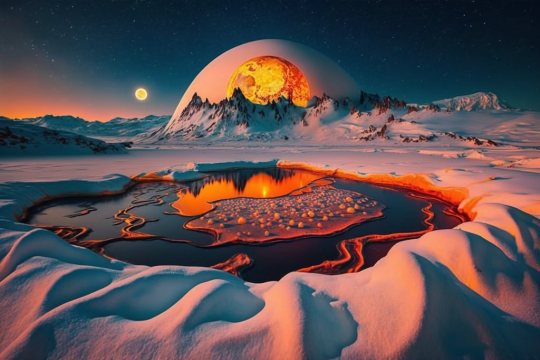
Snow exoplanet with lava ponds . . . The snow exoplanet landscape is a mesmerizing sight, with powdery white snow covering everything as far as the eye can see. But amidst the frozen terrain, there are bubbling lava ponds that light up the night sky with their fiery glow. The stark contrast of the icy snow and the molten lava creates a surreal and otherworldly atmosphere that is both beautiful and dangerous. . . . @bestiaanimalis . . . #art #ai #aiart #digitalart #artwork #artist #artoftheday #photography #photo #photooftheday #artofinstagram #midjourney #special #realistic #midjourneyart #exoplanet #landscape #landscapephotography #snow #lava #pond (hier: Exoplanet) https://www.instagram.com/p/CpAYiNBI3iD/?igshid=NGJjMDIxMWI=
#art#ai#aiart#digitalart#artwork#artist#artoftheday#photography#photo#photooftheday#artofinstagram#midjourney#special#realistic#midjourneyart#exoplanet#landscape#landscapephotography#snow#lava#pond
6 notes
·
View notes
Photo
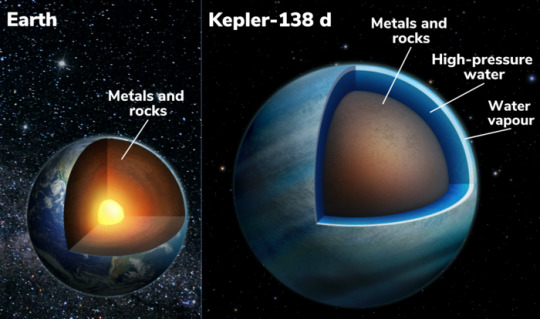
Two exoplanets may be mostly water A team led by UdeM astronomers has found evidence that two exoplanets orbiting a red dwarf star are “water worlds,” planets where water makes up a large fraction of the volume. These worlds, located in a planetary system 218 light-years away in the constellation Lyra, are unlike any planets found in our solar system. The team, led by PhD student Caroline Piaulet of the Trottier Institute for Research on Exoplanets (iREx) at the Université de Montréal, published a detailed study of a planetary system known as Kepler-138 in the journal Nature Astronomy today. Piaulet, who is part of Björn Benneke's research team, observed exoplanets Kepler-138c and Kepler-138d with NASA's Hubble and the retired Spitzer space telescopes and discovered that the planets – which are about one and a half times the size of the Earth – could be composed largely of water. These planets and a planetary companion closer to the star, Kepler-138b, had been discovered previously by NASA’s Kepler Space Telescope. Water wasn’t directly detected, but by comparing the sizes and masses of the planets to models, they conclude that a significant fraction of their volume — up to half of it — should be made of materials that are lighter than rock but heavier than hydrogen or helium (which constitute the bulk of gas giant planets like Jupiter). The most common of these candidate materials is water. "We previously thought that planets that were a bit larger than Earth were big balls of metal and rock, like scaled-up versions of Earth, and that’s why we called them super-Earths," explained Benneke. "However, we have now shown that these two planets, Kepler-138c and d, are quite different in nature: a big fraction of their entire volume is likely composed of water. It is the first time we observe planets that can be confidently identified as water worlds, a type of planet that was theorized by astronomers to exist for a long time.” "We previously thought that planets that were a bit larger than Earth were big balls of metal and rock, like scaled-up versions of Earth, and that’s why we called them super-Earths," explained Benneke. "However, we have now shown that these two planets, Kepler-138c and d, are quite different in nature: a big fraction of their entire volume is likely composed of water. It is the first time we observe planets that can be confidently identified as water worlds, a type of planet that was theorized by astronomers to exist for a long time.” With volumes more than three times that of Earth and masses twice as big, planets c and d have much lower densities than Earth. This is surprising because most of the planets just slightly bigger than Earth that have been studied in detail so far all seemed to be rocky worlds like ours. The closest comparison to the two planets, say researchers, would be some of the icy moons in the outer solar system that are also largely composed of water surrounding a rocky core. “Imagine larger versions of Europa or Enceladus, the water-rich moons orbiting Jupiter and Saturn, but brought much closer to their star,” explained Piaulet. “Instead of an icy surface, Kepler-138 c and d would harbor large water-vapor envelopes." Researchers caution the planets may not have oceans like those on Earth directly at the planet’s surface. “The temperature in Kepler-138c's and Kepler-138d’s atmospheres is likely above the boiling point of water, and we expect a thick, dense atmosphere made of steam on these planets. Only under that steam atmosphere there could potentially be liquid water at high pressure, or even water in another phase that occurs at high pressures, called a supercritical fluid," Piaulet said. Recently, another team at the University of Montreal found another planet, called TOI-1452 b, that could potentially be covered with a liquid-water ocean, but NASA’s James Webb Space Telescope will be needed to study its atmosphere and confirm the presence of the ocean. A new exoplanet in the system In 2014, data from NASA’s Kepler Space Telescope allowed astronomers to announce the detection of three planets orbiting Kepler-138, a red dwarf star in the constellation Lyra. This was based on a measurable dip in starlight as the planet momentarily passed in from of their star, a transit. Benneke and his colleague Diana Dragomir, from the University of New Mexico, came up with the idea of re-observing the planetary system with the Hubble and Spitzer space telescopes between 2014 and 2016 to catch more transits of Kepler-138d, the third planet in the system, in order to study its atmosphere. While earlier NASA Kepler space telescope observations only showed transits of three small planets around Kepler-138, Piaulet and her team were surprised to find that the Hubble and Spitzer observations suggested the presence of a fourth planet in the system, Kepler-138e. This newly found planet is small and farther from its star than the three others, taking 38 days to complete an orbit. The planet is in the habitable zone of its star, a temperate region where a planet receives just the right amount of heat from its cool star to be neither too hot nor too cold to allow the presence of liquid water. The nature of this additional, newly found planet, however, remains an open question because it does not seem to transit its host star. Observing the exoplanet’s transit would have allowed astronomers to determine its size. With Kepler-138e now in the picture, the masses of the previously known planets were measured again via the transit timing-variation method, which consists of tracking small variations in the precise moments of the planets' transits in front of their star caused by the gravitational pull of other nearby planets. The researchers had another surprise: they found that the two water worlds Kepler-138c and d are “twin” planets, with virtually the same size and mass, while they were previously thought to be drastically different. The closer-in planet, Kepler-138b, on the other hand, is confirmed to be a small Mars-mass planet, one of the smallest exoplanets known to date. “As our instruments and techniques become sensitive enough to find and study planets that are farther from their stars, we might start finding a lot more water worlds like Kepler-138 c and d," Benneke concluded. IMAGE....Cross-section of the Earth (left) and the exoplanet Kepler-138 d (right). Like the Earth, this exoplanet has an interior composed of metals and rocks (brown portion), but Kepler-138 d also has a thick layer of high-pressure water in various forms: supercritical and potentially liquid water deep inside the planet and an extended water vapour envelope (shades of blue) above it. These water layers make up more than 50% of its volume, or a depth of about 2000 km. The Earth, in comparison, has a negligible fraction of liquid water with an average ocean depth of less than 4km. CREDIT Benoit Gougeon, Université de Montréal
113 notes
·
View notes